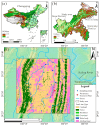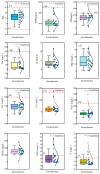Hydrochemical Characteristics, Controlling Factors, and High Nitrate Hazards of Shallow Groundwater in an Urban Area of Southwestern China
- PMID: 40559989
- PMCID: PMC12197245
- DOI: 10.3390/toxics13060516
Hydrochemical Characteristics, Controlling Factors, and High Nitrate Hazards of Shallow Groundwater in an Urban Area of Southwestern China
Abstract
Groundwater nitrate (NO3-) contamination has emerged as a critical global environmental issue, posing serious human health risks. This study systematically investigated the hydrochemical processes, sources of NO3- pollution, the impact of land use on NO3- pollution, and drinking water safety in an urban area of southwestern China. Thirty-one groundwater samples were collected and analyzed for major hydrochemical parameters and dual isotopic composition of NO3- (δ15N-NO3- and δ18O-NO3-). The groundwater samples were characterized by neutral to slightly alkaline nature, and were dominated by the Ca-HCO3 type. Hydrochemical analysis revealed that water-rock interactions, including carbonate dissolution, silicate weathering, and cation exchange, were the primary natural processes controlling hydrochemistry. Additionally, anthropogenic influences have significantly altered NO3- concentration. A total of 19.35% of the samples exceeded the Chinese guideline limit of 20 mg/L for NO3-. Isotopic evidence suggested that primary sources of NO3- in groundwater include NH4+-based fertilizer, soil organic nitrogen, sewage, and manure. Spatial distribution maps indicated that the spatial distribution of NO3- concentration correlated strongly with land use types. Elevated NO3- levels were observed in areas dominated by agriculture and artificial surfaces, while lower concentrations were associated with grass-covered ridge areas. The unabsorbed NH4+ from nitrogen fertilizer entered groundwater along with precipitation and irrigation water infiltration. The direct discharge of domestic sewage and improper disposal of livestock manure contributed substantially to NO3- pollution. The nitrogen fixation capacity of the grassland ecosystem led to a relatively low NO3- concentration in the ridge region. Despite elevated NO3- and F- concentrations, the entropy weighted water quality index (EWQI) indicated that all groundwater samples were suitable for drinking. This study provides valuable insights into NO3- source identification and hydrochemical processes across varying land-use types.
Keywords: drinking water quality; groundwater; land use; nitrate; stable isotopes.
Conflict of interest statement
Author Chang Yang was employed by the company Chongqing Huadi Resources Environment Technology Co., Ltd. The remaining authors declare that the research was conducted in the absence of any commercial or financial relationships that could be construed as a potential conflict of interest.
Figures












Similar articles
-
Nitrate sources and migration in rural karst aquifers: a case study in Pingyin karst catchment, north China.Isotopes Environ Health Stud. 2025 Jul 3:1-18. doi: 10.1080/10256016.2025.2522410. Online ahead of print. Isotopes Environ Health Stud. 2025. PMID: 40605625
-
Hydrochemical evolution and nitrate sources, migration, and transformation in surface water and groundwater of a typical tributary of the Yellow River.J Environ Manage. 2025 Aug;390:126218. doi: 10.1016/j.jenvman.2025.126218. Epub 2025 Jun 21. J Environ Manage. 2025. PMID: 40544811
-
Hydrochemical characterization and genesis mechanisms of springs in the Laiwu area: implications for water quality and health risks.Environ Geochem Health. 2025 Jul 23;47(8):332. doi: 10.1007/s10653-025-02645-z. Environ Geochem Health. 2025. PMID: 40702231
-
A review of the occurrence, distribution, and impact of bitumen seeps on soil and groundwater in parts of southwestern Nigeria.Environ Monit Assess. 2023 Feb 1;195(2):351. doi: 10.1007/s10661-023-10960-0. Environ Monit Assess. 2023. PMID: 36723679 Free PMC article.
-
Individual-level interventions to reduce personal exposure to outdoor air pollution and their effects on people with long-term respiratory conditions.Cochrane Database Syst Rev. 2021 Aug 9;8(8):CD013441. doi: 10.1002/14651858.CD013441.pub2. Cochrane Database Syst Rev. 2021. PMID: 34368949 Free PMC article.
References
-
- Scanlon B.R., Fakhreddine S., Rateb A., De Graaf I., Famiglietti J., Gleeson T., Grafton R.Q., Jobbagy E., Kebede S., Kolusu S.R., et al. Author Correction: Global Water Resources and the Role of Groundwater in a Resilient Water Future. Nat. Rev. Earth Environ. 2023;4:351. doi: 10.1038/s43017-023-00418-9. - DOI
-
- Sforzi L., Sarti C., Santini S., Martellini T., Cincinelli A. Global Status, Risk Assessment, and Knowledge Gaps of Microplastics in Groundwater: A Bibliometric Analysis. Groundw. Sustain. Dev. 2024;27:101375. doi: 10.1016/j.gsd.2024.101375. - DOI
Grants and funding
LinkOut - more resources
Full Text Sources

